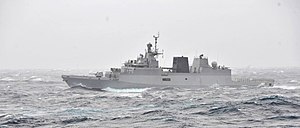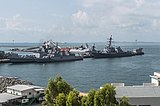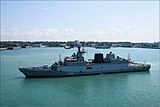
The "Kolkata class" (Project 15A) are a class of stealth guided-missile destroyers constructed for the Indian Navy. The class comprises three ships – Kolkata, Kochi and Chennai, all of which were built by Mazagon Dock Limited (MDL) in India, and are the largest destroyers to be operated by the Indian Navy. Due to delays in construction and sea trials, the initial commissioning date of the first ship of the class was pushed back from 2010 to 2014.

The Brahmaputra-class frigates are guided-missile frigates of the Indian Navy, designed and built in India. They are an enhancement of the Godavari class, with a displacement of 3850 tons and a length of 126 metres (413 ft). Although of similar hull and dimension, internally, the Brahmaputra and Godavari classes have different configurations, armaments and capabilities. 3 ships of this class serve in the Indian Navy.

The Nilgiri-class frigates were updated versions of the Leander class, designed and built for the Indian Navy by Mazagon Dock Limited in Mumbai. Six ships were built between 1972–81. Vessels of the class formed the 14th Frigate Squadron. The lead ship INS Nilgiri was the first major warship to be built in India and was built in collaboration with Yarrow Shipbuilders of the United Kingdom.

Mazagon Dock Shipbuilders Limited (MDL), formerly called Mazagon Dock Limited, is a shipyard situated in Mazagaon, Mumbai. It manufactures warships and submarines for the Indian Navy and offshore platforms and associated support vessels for offshore oil drilling. It also builds tankers, cargo bulk carriers, passenger ships and ferries.
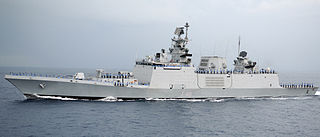
The Shivalik class or Project 17 class is a class of multi-role frigates in service with the Indian Navy. They are the first warships designed with low observability features built in India. They were designed to have better stealth features and land-attack capabilities than the preceding Talwar-class frigates. A total of three ships were built between 2000 and 2010, and all three were in commission by 2012.

Garden Reach Shipbuilders & Engineers Ltd, abbreviated as GRSE, is one of India's leading shipyards, located in Kolkata. It builds and repairs commercial and naval vessels. GRSE also exports the ships that the company builds.

The Kamorta-class corvettes or Project 28 are a class of anti-submarine warfare corvettes currently in service with the Indian Navy. Built at Garden Reach Shipbuilders & Engineers (GRSE), Kolkata, they are the first anti-submarine warfare stealth corvettes to be built in India. Project 28 was approved in 2003, with construction of the lead ship, INS Kamorta commencing on 12 August 2005. All of the four corvettes, INS Kamorta, INS Kadmatt, INS Kiltan and INS Kavaratti were commissioned in 2014, 2016, 2017 and 2020 respectively.
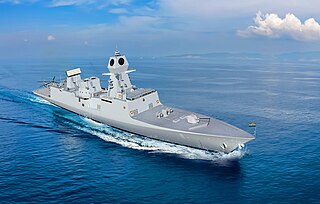
The Nilgiri-class frigates, formally classified as the Project-17 Alpha frigates (P-17A), are a series of stealth guided-missile frigates currently being built by Mazagon Dock Shipbuilders (MDL) and Garden Reach Shipbuilders & Engineers (GRSE), for the Indian Navy. The seventh and final ship of the Project 17A frigates, named Mahendragiri, was launched on 1 September 2023 at the Mazagon Dock by Dr Sudesh Dhankhar, wife of Indian vice-president Jagdeep Dhankhar. It is expected to be commissioned in 2024.

INS Shakti (A57) is a Deepak-class fleet tanker in service with the Indian Navy. She was built by Fincantieri, an Italian shipbuilding company based in Trieste. She is the second and final ship of her class. Shakti, along with her predecessor Deepak, is one of the largest ships of the Indian Navy.

INS Kiltan (P30) is an anti-submarine warfare corvette of the Indian Navy built under Project 28. It is the third of four Kamorta-class corvettes. The ship was built by the Garden Reach Shipbuilders and Engineers (GRSE), Kolkata, launched on 26 March 2013, and commissioned on 16 October 2017. Kiltan represents a leap forward in the Navy's attempts at localisation with as much as 90% of its content drawn from India itself.

INS Kadmatt (P29) is the second of four anti-submarine warfare corvettes built for the Indian Navy by the Garden Reach Shipbuilders and Engineers, of Kolkata, under Project 28. She was inducted into the Eastern Naval Command of the Indian Navy.

The Anti-Submarine Warfare Shallow Water Craft (ASW-SWC) corvettes, are a class of anti-submarine warfare (ASW) vessels currently being built for the Indian Navy, by Cochin Shipyard (CSL) and Garden Reach Shipbuilders & Engineers (GRSE). They were conceived as a replacement to the ageing Abhay-class corvettes of the Indian Navy, and are designed to undertake ASW duties – including subsurface surveillance in littoral waters, search-and-attack unit (SAU) missions and coordinated anti-submarine warfare operations with naval aircraft. They were also designed to provide secondary duties – including defense against intruding aircraft, minelaying and search-and-rescue (SAR).
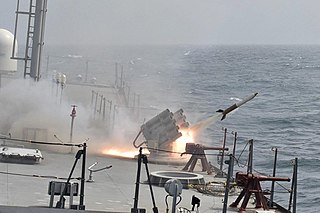
Kavach is an anti-missile naval decoy system to distract radar-guided missiles from their targets and act as a system for self-defence. It was designed and developed by the Ordnance Factory Board for the Indian Navy.

The Indian Navy has been focusing on developing indigenous platforms, systems, sensors and weapons as part of the nation's modernisation and expansion of its maritime forces. As of November 2023, the Indian Navy has 67 vessels of various types under construction including destroyers, frigates, corvettes, conventional-powered and nuclear-powered submarines and various other ships. It plans to build up to a total of 200 vessels and 500 aircraft by 2050. According to the Chief of the Naval Staff's statement in December 2020, India has transformed from a buyer's navy to a builder's navy.

The Visakhapatnam-class destroyers, also classified as the P-15 Bravo class, or simply P-15B, is a class of guided-missile destroyers currently being built for the Indian Navy. The Visakhapatnam class is an upgraded derivative of its predecessor, the Kolkata class, with improved features of stealth, automation and ordnance.
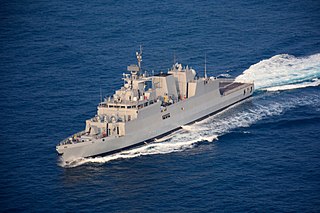
INS Kavaratti (P31) is an anti-submarine warfare corvette of the Indian Navy built under Project 28. It is the last of four Kamorta-class corvettes. The ship was built by the Garden Reach Shipbuilders and Engineers, Kolkata, and launched on 19 May 2015. Kavaratti represents a leap forward in the Navy's attempts at indigenisation with as much as 90% of its content drawn from India itself. It was commissioned into the Navy on 22 October 2020 in Visakhapatnam.

INS Vindhyagiri is a Nilgiri-class frigate of the Indian Navy. It was built at Garden Reach Shipbuilders & Engineers (GRSE) in Kolkata and was formally launched by the President of India, Srimati Droupadi Murmu on 17 August 2023.
